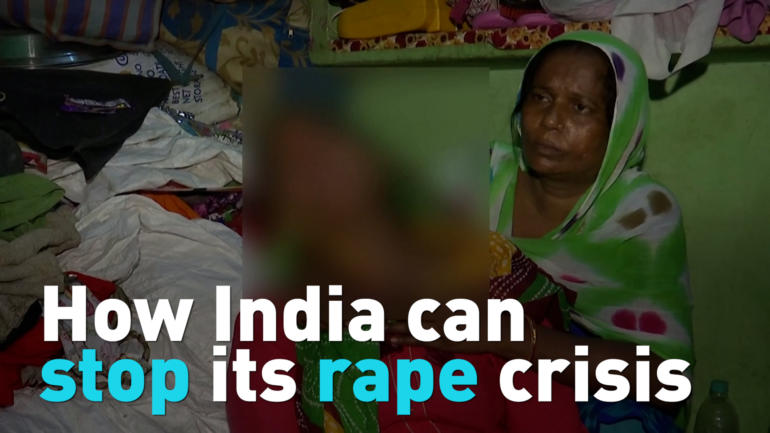High profile cases of sexual violence against women and girls in India seem to follow a similar trajectory. A brutal rape takes place, people protest, officials sometimes make some changes and public admonishments, and then another horrific crime happens.
Earlier this month, people rallied around the parents of a 9-year-old girl who was gang raped, allegedly murdered and then cremated in New Delhi.
Four men ranging in age from 48-63 were arrested, including a priest, for rape, murder, and destroying evidence as well as committing crimes against a child and a caste-based crime.
After the public outcry, the case was fast tracked, politicians visited with the parents, top lawyers are now representing them, and the family as given compensation.
And then, just 10 days later, a 6-year-old girl – also in Delhi – was allegedly raped by her neighbor and another man.
“Every morning, I open the newspaper online and the first thing I’m looking at is rape stories,” said women’s rights activist Shruti Kapoor.
It was another horrific case in 2012 that prompted Kapoor to create the nonprofit Sayfty.
The highly-publicized case involved the gang rape, murder, and mutilation of a 23-year-old woman on a private bus by six men.
Widespread protests led to changes such as creating mandatory sentences for rape, and making rape a crime that could be punishable by death.
Investigations were also conducted into police procedures, and fast-track courts were created specifically to process sexual offenses.
Despite all this, a 2017 poll found that Delhi was the worst megacity in the world for women when it came to sexual violence, rape, and harassment.
But you wouldn’t be able to tell that by looking at the number of reported rape cases.
Across India, government data shows there were only about 33,000 reports of rape of women and children in 2018.
Compared to other nations, this number is low — and suspect.
What this likely shows is that rape and sexual assault is grossly underreported in India.
In fact, one analysis by the website Mint shows that when comparing reported rapes to the National Family Health Survey where surveyors asked 80,000 women questions on sexual and physical violence, it’s estimated that as much as 99.1% of sexual violence cases go unreported.
Enduring class and gender biases in India are at the root of its rape crisis.
While the caste system has been banned in India for more than 70 years, it still permeates every aspect of society.
By the end of 2020, the top 1 percent richest people in India owned 40.5 percent of the nation’s total wealth, according to Credit-Swisse’s Global Wealth Report.
Meanwhile, the bottom 50 percent of the population owns only 2.8 percent of the nation’s wealth, and the divide has only grown during the COVID-19 pandemic, Oxfam found last year.
Nine billionaires in India have the same amount of wealth as the bottom 50 percent of the population – about 650 million people.
The vast inequality in India contributes to a system where men of higher castes are able to commit rape and sexual assault without fear of reporting or punishment.
Women who are of the Dalit or the lowest caste are often targeted by men of higher castes, and victims are bought, pressured, or threatened into silence.
Rape has also been used as a tool to “punish” women of lower castes who step outside caste and gender rules and as a show of power over lower caste men.
And yet even among the privileged higher castes, gender inequality due to ingrained patriarchy remains.
A WHO report found that worldwide, men raised in families with strongly patriarchal structures are also more likely to become violent, to rape and to use sexual coercion against women, and as well as to abuse their intimate partners, compared to men raised in homes that are more egalitarian.
The reoccurring number of rapes in India have experts worried that people are becoming desensitized to the crimes.
So what does India need to do to end its rape crisis?
“The justice system needs to be reformed, our police force needs to be gender sensitized, judges need to be gender sensitized you can’t have judges who are still victim blaming,” Kapoor said. “Our courts are so overburdened that you may not get a hearing for many years.”
Activists are also pushing for faster movement on the current backlog of rape cases in special fast track courts. As of August, there were 234,000 pending rape cases.
Many are also angry that India’s law doesn’t address marital rape.
Data from the National Family Health Survey has found that the average woman in India is 17 times more likely to face sexual violence from her husband than others.
India’s penal code only criminalizes forced sex in marriages if the wife is under the age of 15. The only option for a victim of marital rape is to file a civil case against the attacker.
The penal code also only defines rape as a crime perpetrated by men on female victims.
Lawmakers have tried — but have not succeeded — in changing the rape laws in India to be gender neutral.
There’s no data on male victims of rape in India, but a 2007 government study of more than 12,000 children showed that 53 percent faced one or more forms of sexual abuse, and of that group, the majority or 53 percent were boys.
Outside of what needs to change within the system, Kapoor says people’s minds also need to change.
Kapoor’s organization has created an app to teach people to know what to do and where to go when a sexual assault happens and host weekly Twitter chats on sexual violence with experts.
They also offer self-defense workshops to women, and go into schools to teach boys and girls as young as five what a safe and unsafe touch is. They also work with older students to discuss gender stereotypes and consent.
Things are changing, Kapoor said.
“You are seeing visible change, it’s just that it is so slow and the crimes keep happening at such a continuous rate that you feel like there’s no change happening but that’s not true,” Kapoor said.
“Women are more aware, they are better empowered, and they have social media. Twenty years ago we didn’t have social media… now if a rape case happens suddenly you see it trending on Twitter.”
 CGTN America
CGTN America

